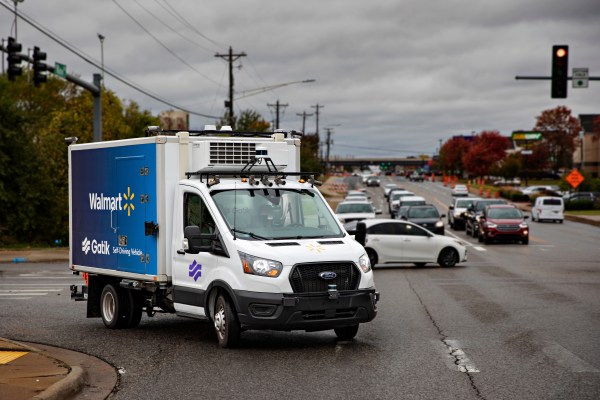Autonomous vehicle startup Gatik has reached a new milestone in its partnership with Walmart and within the industry.
Gatik said Monday it has pulled the safety operator from behind the wheel of two self-driving box trucks that operate in Walmart’s home turf of Bentonville, Arkansas. This means the startup’s box trucks are driverless on a commercial route — a first for the industry, according to Gatik CEO and co-founder Gautam Narang.
Gatik has taken a different approach from other competitors in the autonomous vehicle sector. The Palo Alto-based startup isn’t targeting consumers. Instead, Gatik uses its autonomous trucks to shuttle groceries and other goods from large distribution centers to retail locations. Gatik, which came out of stealth in 2019, has been shuttling goods for Walmart in Arkansas and Louisiana, and for Loblaw Companies Limited in Ontario, Canada.
More recently, Gatik expanded into Texas following a Series B fundraising round of $85 million. Gatik has 25 self-driving trucks in its total fleet, which are spread out among Arkansas, Louisiana, Texas, California and Canada.
Gatik first started driverless operations in August, which TechCrunch noted at the time. Walmart and Gatik have now released more details about the driverless operations. Gatik has five self-driving trucks operating in Arkansas, which are used to shuttle goods for Walmart. Two of these trucks are fully driverless now and operate seven days a week on a 7.1-mile route between a Walmart fulfillment center (or dark store) and one of its neighborhood markets.
Gatik still has safeguards in place, however. An employee is in the passenger seat of the truck, there is a chase vehicle and it only operates in fair weather conditions. A third-party company evaluated the self-driving system prior to launching the driverless operations, Narang said.
Narang told TechCrunch the aim is to scale fully driverless operations across its other sites as well — and at a faster pace. “It took us about 24 months since our commercial launch to get to a point where we could safely take the driver out,” he said. “That time to unmanned will be reducing over time. Basically, getting to fully driverless operations in new markets and in new routes will become faster.”
